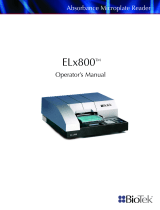Thermo Fisher Scientific Mycobacterium paratuberculosis Test Kit User guide
- Type
- User guide

Mycobacterium paratuberculosis Test Kit for Cattle
PARACHEK® 2
An in vitro diagnostic test kit for detection of antibodies to Mycobacterium avium ssp.
paratuberculosis in serum of cattle, sheep and goat and milk of cattle
1
184 Maximum Test Samples – Two (2) Microplate Test Kit
460 Maximum Test Samples – Five (5) Microplate Test Kit.
2760 Maximum Test Samples – Thirty (30) Microplate Test Kit
© Prionics AG
Version 3.0_e
For in vitro veterinary diagnostic laboratory use only.
Store at 5±3°C
Product No.: 63325/63327/63328
The protocol for milk samples has been optimized and validated
by Antel BioSystem Inc.
Introduction
Johne’s disease is a chronic, debilitating enteritis of
ruminants caused by infection with Mycobacterium
paratuberculosis.
During the active stage of infection and prior to onset
of clinical disease, animals generally develop antibod-
ies to M. paratuberculosis antigens. Uninfected ani-
mals lack specific antibodies to M. paratuberculosis,
but may have cross-reacting antibodies to other
mycobacteria. These cross reacting antibodies can be
removed by absorption of serum/plasma with M. phlei
prior to commencement of the EIA1.
The automated version of the PARACHEK® 2 is based
on the original Johne’s absorbed EIA and shows the
same high performance. It detects antibodies to M.
paratuberculosis in serum, plasma and milk and may
be used as a specific test for Johne’s disease in cattle.
This original PARACHEK® 2 has been evaluated on
animals from Johne’s disease-endemic and Johne’s
disease-free regions of Australia2 and the United
States3. The test specificities were 99% or greater for
cattle, sheep and goats. Calculations of sensitivity
were affected by the history of the cattle herd under
test. However, the EIA detected up to 80% of animals
before onset of clinical disease and 60-65% of faecal
shedders were EIA positive on or before first detection
of M. paratuberculosis in their faeces2. For sheep, the
test sensitivity estimates were 38-44%4 and for goats,
the sensitivity ranged from 65-88%5.
The test should permit epidemiological studies and be
a useful tool in the management and control of
Johne’s disease in cattle, goat and sheep.
Test Principle
The Method used is described in OIE Terrestrial
Manual 2012, Vol.1, chapter 2.1.11 (Paratuberculosis
(Johne’s disease)).
The test involves four separate stages:
Stage 1
Serum/milk samples are diluted and incubated in
Green Diluent Buffer containing M. phlei to remove
cross-reacting antibodies.
Stage 2
Antibodies in serum/milk samples are reacting with M.
para-tuberculosis antigens bound to a solid support.
Non binding antibodies are removed by washing after
a suitable incubation time.
Stage 3
Conjugate (horseradish peroxidase labelled anti-
bovine Ig) reacts with immunoglobulins bound to the
solid-phase antigen. Non binding conjugate is re-
moved by washing after a suitable incubation time.
Stage 4
Enzyme Substrate is added. The rate of conversion of
substrate is proportional to the amount of bound
immunoglobulin. The reaction is stopped and the
colour development is measured colorimetrically.
The 92 sample test in 1 plate can be finished in 90
minutes included sample pre-absorption.
Kit Components
Store kit at 5±3°C until expiry date. See kit label for
actual expiry date. The shelf life of diluted, opened or
reconstituted components is noted below, when
appropriate. Chemical hazard data are available in
section “Safety Regulations and R&S Statements”.
Product Numbers
Two (2) Microplate Test Kit: 63327
Five (5) Microplate Test Kit 63325
Thirty (30) Microplate Test Kit: 63328
Component 1
Microtitre Plates coated with M. paratuberculosis
63327: 2 x 96 well plates with lids
63325: 5 x 96 well plates with lids
63328: 30 x 96 well plates with lids
Ready for use.
Component 2
Positive Control
63327: 1 x 0.75 ml
63325: 1 x 1.0 ml
63328: 1 x 2.0 ml
Contains 0.01% w/v thimerosal.
Ready for use.
Component 3
Negative Control
63327: 1 x 0.75 ml
63325: 1 x 1.0 ml
63328: 1 x 2.0 ml
Contains 0.01% w/v thimerosal.
Ready for use.
Component 4
Green Diluent: Sample diluent buffer
63327: 1 x 100 ml
63325: 1 x 250 ml
63328: 3 x 500 ml
Contains 0.01% w/v thimerosal.
Ready for use.
Component 5
Wash Buffer – 20x Concentrate
63327: 1 x 100 ml
63325: 1 x 250ml
63328: 2 x 500 ml
Contains 0.01% w/v thimerosal.
Dilute with purified water.
Component 6
Conjugate – 100x Concentrate (Horseradish peroxi-
dase labelled anti-bovine Ig.)
63327: 1 x 0.5 ml
63325: 1 x 0.75 ml
63328: 2 x 2 ml
Contains 0.01% w/v thimerosal.
Dilute with Blue Diluent.
Component 7
Blue Diluent: Conjugate diluent buffer
63327: 1 x 30 ml
63325: 1 x 75ml
63328: 2 x 200 ml
Contains 0.01% w/v thimerosal.
Ready for use.
Component 8
Enzyme Substrate
63327: 1 x 30 ml
63325: 1 x 75ml
63328: 2 x 200 ml
Ready for use.
Component 9
Enzyme Stopping Solution
63327: 1 x 15 ml
63325: 1 x 50 ml
63328: 1 x 200 ml
(0.5M H2SO4)
Ready for use.
General Precautions
1. Laboratory Safety
Correct laboratory procedures should be applied at
all times.
2. Enzyme Stopping Solution
The Enzyme Stopping Solution is a strong acid.
Wipe up spills immediately. Flush the area of the
spill with water. If the stopping solution contacts the
skin or eyes, flush with copious quantities of water
and seek medical attention.
Equipment required but not provided
• Accurate, replaceable-tip variable-volume pi-
pettes (to deliver 475 µl, 25 µl and 10 to 120 µl)
• Graduated 1, 5 and 10 ml pipettes
• Measuring cylinders - 100 ml, 1 litre and 2 litres
• Suitable microtitre plate washer/dispenser
• Suitable microplate shaker
• Multichannel pipette (to deliver 50 and 100 µl)
• Suitable microtitre plate reader. This reader
MUST be fitted with filters to read at 450 nm and
620-650 nm.
• Dummy plate, used for sample dilution (e.g.clear
colorless round bottom 96 well plates) or
equivalent; non binding
Preparation of Reagents
1. Microtitre Plates coated with M. paratuberculo-
sis
Allow plates to equilibrate to room temperature
(22±3°C) for at least 30 minutes before unsealing
plastic pouch.
2. Positive and Negative Controls
Bring to room temperature (22±3°C) and mix each
thoroughly.
3. Green Diluent
Sample diluent buffer. Bring to room tempera-
ture(22±3°C) and mix thoroughly. (Ready-to-use).
4. Blue Diluent
Conjugate diluent buffer. Bring to room tempera-
ture(22±3°C) and mix thoroughly. (Ready-to-use).
5. Conjugate 100x Concentrate
Conjugate 100x Concentrate MUST be stored at
5±3°C at all times.
Package Insert

2
PARACHEK
®
2
6. Preparation of Conjugate
Bring Blue Diluent (Conjugate diluent buffer) to
room temperature (22±3°C) then mix thoroughly
with Conjugate 100x Concentrate to make conju-
gate reagent ready for use. Suitable volumes are
presented in the Conjugate Preparation Table
(Table 1).
Return Conjugate 100x Concentrate to 5±3°C im-
mediately after use.
7. Wash Buffer – 20x Concentrate
Prepare working solution Wash Buffer by thor-
oughly mixing one part 20x concentrate with 19
parts purified water. Working solution Wash Buffer
may be stored at room temperature (22±3°C) for up
to 2 weeks.
8. Enzyme Substrate
Bring Enzyme Substrate to room temperature
(22±3°C) for at least 30 minutes prior to use. En-
zyme Substrate should be clear and colourless.
Discard if blue coloration or any evidence of precipi-
tation occurs. Tip the required volume into a vessel
for use. Do not pipette in the supplied bottle, do not
return unused solution to bottle.
DO NOT USE POLYSTYRENE CONTAINERS OR
PIPETTES.
Any glassware used with the Enzyme Substrate
should be rinsed thoroughly with 1N H2SO4 or HCl
followed by at least three washes of purified water,
ensuring no acid residue remains on the glassware.
When using a liquid handler protect Enzyme Sub-
strate from direct light and from evaporation.
CONJUGATE PREPARATION TABLE (TABLE 1)
Number of Volume of Volume of
strips concentrate diluent
1 10 µl 1 ml
2 20 µl 2 ml
3 30 µl 3 ml
4 40 µl 4 ml
5 50 µl 5 ml
6 60 µl 6 ml
7 70 µl 7 ml
8 80 µl 8 ml
9 90 µl 9 ml
10 100 µl 10 ml
11 110 µl 11 ml
12 120 µl 12 ml
Procedural Notes
1. Allow all reagents except the Conjugate 100x
Concentrate to equilibrate to room temperature
(22±3°C) for at least 30 minutes before use.
NOTE: Refer to special requirements for Green
Diluent.
2. All kit components are to be stored at 5±3°C.
Return to 5±3°C immediately after use. Wash
Buffer working solution may be stored at room tem-
perature for up to 2 weeks.
3. The Conjugate 100x Concentrate must be left at
5±3°C at all times.
4. Use a separate disposable tip for each sample to
prevent cross contamination.
5. Test samples may be assayed in duplicate in
adjacent wells.
6. The assay has been validated for serum/plasma
and milk samples. The protocol is optimized for
fresh, frozen and preserved whole milk samples.
Do not use colostrum or milk within 1 week of calv-
ing. A 1:2 dilution is applied only for the milk sam-
ples, the dilution of serum samples, Positive and
Negative Controls remains at 1:20.
7. Positive and Negative Controls must be assayed in
duplicate. For convenience, controls may be lo-
cated at the beginning of each plate (eg. Positive
Controls in wells A1 & B1, Negative Controls in well
C1 & D1).
Test Procedure
1. Equilibrate all reagents except the Conjugate 100x
Concentrate.
2. Dilute serum samples 1:20 and milk samples 1:2 in
Green Diluent in dummy plate, eg. 15 µl of test se-
rum and control samples in 285 µl Green Diluent for
duplicate test or 10 µl sample plus 190 ul Green
Diluent for single test or 150 µl milk in 150 µl Green
Diluent for duplicate test. Mix the sample and
Green diluent thoroughly either by pipetting up and
down several times or by a microplate shaker for at
least 1 minute with moderate speed. The reaction
time of sample with Green Diluent may be from 1
minute up to 24 hours.
3. Transfer 100 µl of test and control samples from
dummy plate to corresponding wells of the Microti-
tre Plate coated with M. paratuberculosis antigen.
4. Cover each plate with a lid and incubate at room
temperature (22±3°C) for 30±3 minutes. Conjugate
100x Concentrate should be diluted ready for use at
the end of the washing step. In the case of per-
formance in automat, the conjugate may be used
up to 8 hours after dilution at room temperature
(22±3°C).
5. Wash plate 3x300 µl with Wash Buffer by using a
plate washer with a suitable wash-program. If man-
ual washing is applied, please take care not to
cross contaminate adjacent wells. Shake out wash
fluid as much as possible after each washing cycle.
After the last washing cycle, tap trays face down
several times on lint-free absorbent paper or similar
materials to remove as much remaining wash buffer
as possible.
6. Add 100 µl of freshly prepared conjugate solution to
each well (see table 1).
7. Cover each plate with a lid and incubate at room
temperature (22±3°C) for 30±3 minutes.
8. Wash plate as in Step 5.
9. Add 100 µl of Enzyme Substrate to each well.
10. Cover each plate with a lid, shake and incubate at
room temperature (22±3°C) for 15-20 mins.
11. Add 50 µl of Enzyme Stopping Solution to each
well, then mix by gentle agitation.
NOTE: The Enzyme Stopping Solution should be
added to wells in the same order and at the same
speed as the Enzyme Substrate.
12. Read the absorbance of each well using a 450 nm
filter, use 620 nm as reference wavelength within
30 minutes after terminating the reaction. The ab-
sorbance values will then be used to calculate re-
sults.
Validation of Test Performance
The control results must be examined before the
sample results can be interpreted.
Determine the mean absorbance of Negative and
Positive Controls.
Acceptance criteria
- The mean corrected value of Positive Control (PC)
is greater than 0.500.
ODPC > 0.500
- The mean corrected value of Positive Control (PC)
is greater than 5 times the corrected value
of Negative Control (NC)
ODPC/ODNC > 5
The run is invalid if either of these criteria is not met
and must be repeated.
ODPC = mean value of Positive Control
ODNC = mean value of Negative Control
The percent positivity (%P, PP) of PC is considered as
100%.
Interpretation of Results
• Results of bovine and ovine serum samples which
are above or equal to the cut-off of 15 Percent Posi-
tivity (%P), or bovine milk samples which are above
or equal to the cut-off of 10%P are considered as
positive. A positive result indicates that the animal
is likely to be infected with M. paratuberculosis and
that there are potentially other infected animals
within the herd.
Results of bovine and ovine serum samples which
are below the cut-off of 15 Percent Positivity (%P),
or bovine milk samples which are below the cut-off
of 10%P are considered as negative. A negative
result on a single animal can only be interpreted
when the paratuberculosis history and test results
of the entire herd is known. Even though animals
are generally infected as neonates, an immune
response does not develop immediately. Current
information suggests that seroconversion gener-
ally occurs before any clinical signs are apparent.
As with any biological test, this test may occasion-
ally give a false positive or false negative result due
to local conditions. A test should be interpreted in
the context of all available clinical, historical and
epidemiological information relevant to the ani-
mal(s) under test. Further confirmatory testing may
be required in certain circumstances.
Responsibility for test interpretation and consequent
animal husbandry decisions rests solely with the user
and, any consulting veterinarian and appropriate
animal health advisers or authorities.
Prionics AG accepts no responsibility for any loss or
damage, howsoever caused, arising from the interpre-
tation of test results.
Technical Information
Follow the PARACHEK® 2 (Johne’s Absorbed EIA) kit
instructions as closely as possible, as any deviation
may reduce the performance of the test and lead to
erroneous results.
1. Vortex mixing of conjugate in the Blue Diluent may
reduce kit performance if it is done too vigorously.
Vortex mixing should be done at a moderate speed,
‘stop-starting’ 3-4 times, in order to prevent or
minimise frothing of the diluent. This approach
should be used whenever vortex mixing any bio-
logical reagents.
However, not mixing enough may also lead to prob-
lems. Remember, it is impossible to over mix, as
long as it is done gently. For accurate and repro-
ducible results always ensure that conjugate is ho-
mogenously mixed.
2. The kit instructions specify that when reagents are
added to the plate, the plate should then be mixed
by shaking. Deviation from this instruction may
lower the reproducibility of the assay and lead to
invalid results. After each reagent is added to the
plate, the plate is to be placed on a plate shaker
and shaken for at least one minute. The plate
should also be similarly mixed before any optical
reading is performed.
3. Blanking of EIA readers can be problematic. It
appears that different readers blanked differently
result in vastly different absorbance readings for the
Calculation of sample result

3
PARACHEK
®
2
negative control. All readers should be blanked us-
ing a new unused plate or strip.
General Remarks
Notice
This manual is believed to be complete and accurate
at the time of publication. In no event shall Prionics AG
be liable for incidental or consequential damage in
connection with or arising from the use of this manual.
Liability
Prionics AG warrants its products will meet their
applicable published specification when used in
accordance with their applicable instructions and
within the declared products life time. Prionics AG
makes no other warranty, expressed or implied. There
is no warranty of merchantability or fitness for a par-
ticular purpose. The warranty provided herein and the
data, specifications and descriptions of Prionics AG
products appearing in Prionics AG published cata-
logues and product literature may not be altered
except by express written agreement signed by an
officer of Prionics AG. Representation, oral or written,
which are inconsistent with this warranty or such
publications are not authorized and if given, should not
be relied upon.
In the event of a breach of the foregoing warranty,
Prionics AG’s sole obligation shall be to repair or
replace, at its option, the applicable product or part
thereof, provided the customer notifies Prionics AG
promptly of any such breach. If after exercising rea-
sonable efforts, Prionics AG is unable to repair or
replace the product or part, then Prionics AG shall
refund to the customer all money paid for such appli-
cable product or part.
Prionics AG shall not be liable for consequential,
incidental, special or any other indirect damages
resulting from economic loss or property damage
sustained by any customer from the use of its prod-
ucts.
Prionics AG is an ISO 9001:2008 certified company.
Safety Regulations / R&S Statements
Safety Regulations and R&S Statements
National Safety Regulations must be strictly fol-
lowed.
R&S Statements
Component 1
Microtitre Plates coated with M. paratuberculosis
Hazard Code: This product is not classified according
to EU regulations.
Component 2
Positive Control
Hazard Code: This product is not classified according
to EU regulations.
Component 3
Negative Control
Hazard Code: This product is not classified according
to EU regulations.
Component 4
Green Diluent: Sample diluent buffer
Hazard Code: This product is not classified according
to EU regulations.
Component 5
Wash Buffer – 20x Concentrate
Hazard Code: This product is not classified according
to EU regulations.
Component 6
Conjugate – 100x Concentrate
(Horseradish peroxidase labelled anti-bovine Ig.)
Hazard Code: This product is not classified according
to EU regulations.
Component 7
Blue Diluent: Conjugate diluent buffer
Hazard Code: This product is not classified according
to EU regulations.
Component 8
Enzyme Substrate
Hazard Code: This product does not have to be
labelled due to the calculation procedure of the “Gen-
eral Classification guideline for preparations of the EU”
in the latest valid version.
Component 9
Enzyme Stopping Solution
Hazard Code: C Corrosive
R34: Causes burns.
S20: When using do not eat or drink.
S26: In case of contact with eyes, rinse immediately
with plenty of water and seek medical advice.
S35: This material and its container must be disposed
of in a safe way.
S36/37/39: Wear suitable protective clothing, gloves
and eye/face protection.
S45: In case of accident or if you feel unwell, seek
medical advice immediately (show the label where
possible).
References
1 Milner AR, Mack WN, Coates KJ, Hill J, Gill I,
Sheldrick P. The sensitivity and specificity of a
modified ELISA for the diagnosis of Johne’s dis-
ease from a field trial in cattle. Vet Micro 1990; 25:
193-8.
2 Cox JC, Drane DP, Jones SL, Ridge S, Milner AR.
Development and evaluation of rapid absorbed en-
zyme immunoassay test for the diagnosis of
Johne’s disease in cattle. Aust Vet J 1991; 68: 157-
60.
3 Collins MT, Sockett DC, Ridge S, Cox JC. Evalua-
tion of a commercial enzyme-linked immunosorbent
assay for Johne’s disease. J Clin Micro 1991; 29:
272-6.
4 Hope AF, Kluver PF, Jones SL, Condron RJ.
Sensitivity and specificity of two serological tests for
the detection of ovine paratuberculosis. Aust Vet J
2000; 78: 850-6.
5 Whittington RJ, Eamons GJ, Cousins DV. Specific-
ity of absorbed ELISA and agar gel immunodiffu-
sion tests for paratuberculosis in goats with obser-
vations about use of these tests in infected goats.
Aust Vet J 2003; 81: 71-5.
Contacts
www.prionics.com
North America:
Prionics USA, Inc. Tel: + 1-402-896-2200
10064 South 134th Str. Fax: + 1-402-896-2201
Omaha, NE 68138
United States
Australia/New Zealand:
AsureQuality Ltd Tel:+61-38318-9000(AUS)
28 Mareno Road Tel:+64-9-573 8000 (NZ)
Tullamarine Fax:+6138318-9001(AUS)
Victoria 3043, Australia Fax:+64-9-573-8001(NZ)
All other countries:
Prionics AG Tel: +41 44 200 2000
Wagistrasse 27a Fax +41 44 200 2010
8952 Schlieren-Zurich Email: [email protected]
Switzerland
PARACHEK® 2 is manufactured by:
AsureQuality Australia Pty Ltd
28 Mareno Road
Tullamarine
Victoria 3043, Australia
PARACHEK® 2 is manufactured for:
Prionics AG
Wagistrasse 27a
8952 Schlieren-Zurich
Switzerland
-
 1
1
-
 2
2
-
 3
3
Thermo Fisher Scientific Mycobacterium paratuberculosis Test Kit User guide
- Type
- User guide
Ask a question and I''ll find the answer in the document
Finding information in a document is now easier with AI
Related papers
-
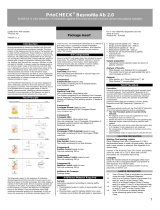 Thermo Fisher Scientific PrioCHECK Besnoitia Ab 2.0 serum plasma bovine 7610530 User guide
Thermo Fisher Scientific PrioCHECK Besnoitia Ab 2.0 serum plasma bovine 7610530 User guide
-
 Thermo Fisher Scientific PrioCHECK Brucella Ab serum milk cattle sheep goat 7610400 User guide
Thermo Fisher Scientific PrioCHECK Brucella Ab serum milk cattle sheep goat 7610400 User guide
-
 Thermo Fisher Scientific PrioCHECK Brucella Ab 2.0 serum milk cattle serum sheep goat 7610700 User guide
Thermo Fisher Scientific PrioCHECK Brucella Ab 2.0 serum milk cattle serum sheep goat 7610700 User guide
-
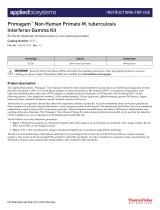 Thermo Fisher Scientific Primagam Non‑Human Primate M. tuberculosis Interferon‑Gamma Kit Operating instructions
Thermo Fisher Scientific Primagam Non‑Human Primate M. tuberculosis Interferon‑Gamma Kit Operating instructions
-
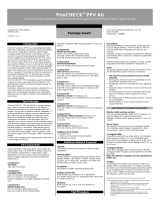 Thermo Fisher Scientific PrioCHECK PPV Ab serum pig 7588981 User guide
Thermo Fisher Scientific PrioCHECK PPV Ab serum pig 7588981 User guide
-
 Thermo Fisher Scientific PrioCHECK Salmonella Ab bovine plasma serum cattle 7610620 User guide
Thermo Fisher Scientific PrioCHECK Salmonella Ab bovine plasma serum cattle 7610620 User guide
-
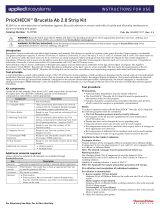 Thermo Fisher Scientific PrioCHECK Brucella Ab 2.0 Strip Kit Operating instructions
Thermo Fisher Scientific PrioCHECK Brucella Ab 2.0 Strip Kit Operating instructions
-
 Thermo Fisher Scientific PrioCHECK Salmonella Ab bovine milk cattle 7610620 User guide
Thermo Fisher Scientific PrioCHECK Salmonella Ab bovine milk cattle 7610620 User guide
-
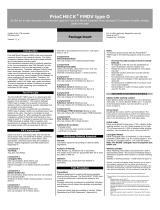 Thermo Fisher Scientific PrioCHECK FMDV type O serum cattle sheep goat pig 7610430 User guide
Thermo Fisher Scientific PrioCHECK FMDV type O serum cattle sheep goat pig 7610430 User guide
-
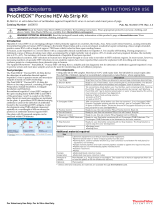 Thermo Fisher Scientific PrioCHECK Porcine HEV Ab Strip Kit Operating instructions
Thermo Fisher Scientific PrioCHECK Porcine HEV Ab Strip Kit Operating instructions













